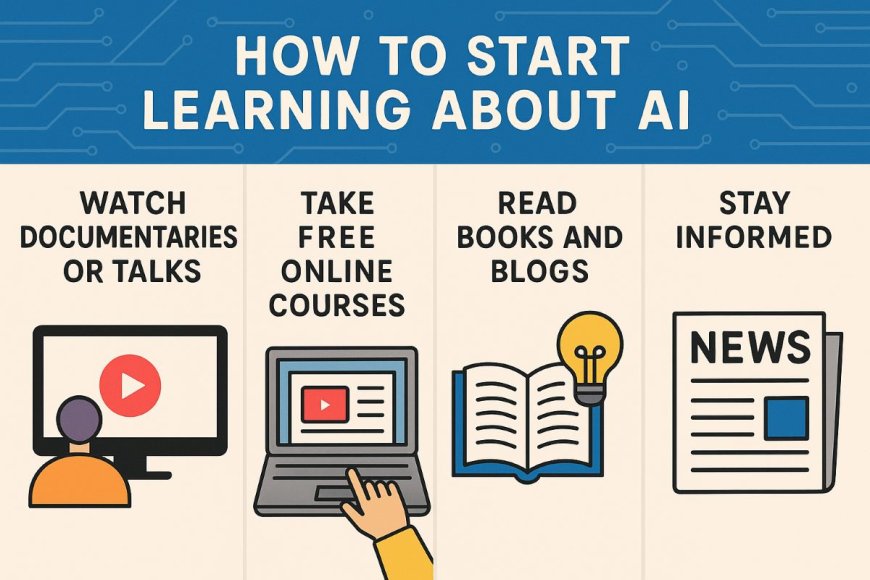Understanding AI: A Beginner's Guide to Artificial Intelligence
Explore how Artificial Intelligence is reshaping technology, business, and society with smart, data-driven decision-making.

In the 21st century, Artificial Intelligence (AI) is no longer just a concept found in science fiction novels and movies — it is a part of our daily lives. From the voice assistants on our phones to personalized recommendations on streaming platforms, AI has become an invisible partner in our routines. But what exactly is AI? How does it work? And why is it such a transformative force in today’s world?
This beginner’s guide will help demystify AI, breaking it down in a clear and accessible way so that anyone — regardless of technical background — can understand the basics of this revolutionary technology.
What is Artificial Intelligence?
At its core, Artificial Intelligence refers to the ability of machines to perform tasks that typically require human intelligence. These tasks include learning, reasoning, problem-solving, understanding language, and even perceiving the world visually.
AI doesn’t mean creating human-like robots (though that’s one part of it). It’s more about enabling machines — particularly computers — to analyze data, learn from it, and make decisions or predictions based on that learning.
AI can be found in countless applications today, such as:
-
Voice assistants like Siri, Alexa, and Google Assistant
-
Self-driving cars that detect lanes and obstacles
-
Email spam filters that recognize unwanted messages
-
Recommendation engines on platforms like Netflix, YouTube, or Amazon
-
Chatbots used by customer service teams
The Different Types of AI
AI comes in various forms, typically classified into three broad categories:
1. Narrow AI (Weak AI)
This is the most common type of AI today. Narrow AI is designed to perform a specific task, such as recognizing faces, filtering emails, or playing chess. These systems may seem smart, but they operate within a limited scope. For example, a chess-playing AI cannot translate languages or drive a car.
2. General AI (Strong AI)
This form of AI would be able to perform any intellectual task that a human can do — reasoning, creativity, learning, emotional understanding — all at once. General AI doesn’t exist yet and remains a goal for researchers.
3. Superintelligent AI
This hypothetical type of AI would surpass human intelligence in every field, including creativity, problem-solving, and social intelligence. While still in the realm of speculation, it raises ethical and philosophical questions about the future of human and machine coexistence.
How AI Works: The Basics
To understand AI, it's helpful to grasp the key technologies behind it:
1. Machine Learning (ML)
Machine learning is a subset of AI that allows computers to learn from data without being explicitly programmed. Instead of writing rules for every task, programmers provide large amounts of data, and the machine finds patterns or relationships in it.
For example, to teach an AI to recognize cats in photos, you feed it thousands of images labeled "cat" and "not cat." Over time, the system learns to identify features that distinguish cats — like whiskers, ears, and tails.
2. Deep Learning
Deep learning is a type of machine learning that uses neural networks — systems modeled after the human brain — with many layers ("deep" structures). This approach is behind the most advanced AI systems today, including voice recognition, image classification, and natural language understanding.
3. Natural Language Processing (NLP)
NLP enables machines to understand and respond to human language. It's how AI reads your emails, translates languages, or powers chatbots. Tools like ChatGPT, for example, rely on sophisticated NLP to engage in human-like conversations.
Common Myths About AI
"AI is going to take all our jobs."
While it's true that AI will automate some tasks, it also creates new jobs and roles. The key lies in adaptation — learning how to work alongside AI, not compete against it.
"AI can think like a human."
AI can process data and recognize patterns, but it doesn't think or feel. It has no consciousness or understanding — it follows algorithms based on training.
"AI is infallible."
AI can make mistakes, especially when trained on biased or incomplete data. Human oversight remains critical.
Real-Life Applications of AI
AI is making a real difference across various sectors:
Healthcare
AI assists in diagnosing diseases from X-rays or MRIs, predicting patient outcomes, and personalizing treatment plans.
Finance
Banks use AI for fraud detection, risk assessment, and automating customer service.
Retail
Online stores use AI to analyze customer behavior and offer personalized product suggestions.
Transportation
AI powers navigation apps, traffic predictions, and autonomous vehicle technology.
Education
AI-driven tutoring systems adapt to each student’s learning pace, providing personalized feedback.
Ethical Considerations in AI
As AI becomes more powerful, it also raises serious ethical questions:
-
Bias in AI: If the data used to train AI is biased, the system can produce unfair results. This is especially problematic in areas like hiring, policing, and lending.
-
Privacy: AI systems often rely on massive amounts of personal data. Protecting that data and ensuring transparency in its use is critical.
-
Accountability: When an AI system makes a mistake — such as a self-driving car accident — who is responsible?
Developing ethical, inclusive, and transparent AI is a major priority for researchers, companies, and governments around the world.
How to Start Learning About AI
You don’t need to be a computer scientist to start learning about AI. Here are a few steps for beginners:

-
Watch Documentaries or Talks
TED Talks, YouTube series, and Netflix documentaries (like The Social Dilemma) offer great insights. -
Take Free Online Courses
Platforms like Coursera, edX, and Khan Academy offer beginner-friendly courses on AI and machine learning. -
Read Books and Blogs
Books like "AI Superpowers" by Kai-Fu Lee and "Life 3.0" by Max Tegmark offer a broader understanding of AI’s potential and challenges. -
Stay Informed
Follow tech news websites, AI research blogs, and newsletters to keep up with developments.
Conclusion: AI is Here to Stay
Artificial Intelligence is reshaping the world in ways we’re only beginning to understand. Whether you’re a student, a professional, or simply a curious reader, understanding the basics of AI is essential in today’s digital age.
By learning how AI works and recognizing its opportunities and challenges, you empower yourself to be an informed participant in the future it’s helping to build. AI isn’t just about robots or high-tech labs — it’s about making smarter decisions, solving complex problems, and reimagining what’s possible for humanity.
So the next time your smartphone recommends a song, or your car helps you navigate traffic, remember — you’ve just had a conversation with artificial intelligence

































































































































































